Analyzing the Impact of Corporate Social Responsibility on Performance
VerifiedAdded on 2022/11/14
|33
|8780
|370
Report
AI Summary
This dissertation report examines the impact of corporate social responsibility (CSR) on organizational performance, using House of Fraser as a case study. The report begins with an introduction to CSR, its importance, and the background of the study, highlighting the increasing significance of CSR in developed economies and its evolution from profit maximization to addressing social issues. It presents the research problem, objectives, and questions, followed by the methodology, which involves secondary research and data collection from various sources. The literature review explores CSR, corporate social initiatives, and their impact on supply chains. The report also includes a business plan with an executive summary, company concept, market analysis, and financial projections. Finally, the report presents proposed solutions, risk analysis, and alternative approaches, culminating in conclusions and limitations. The report contributes to understanding how businesses implement CSR activities and the impact of CSR on business performance.
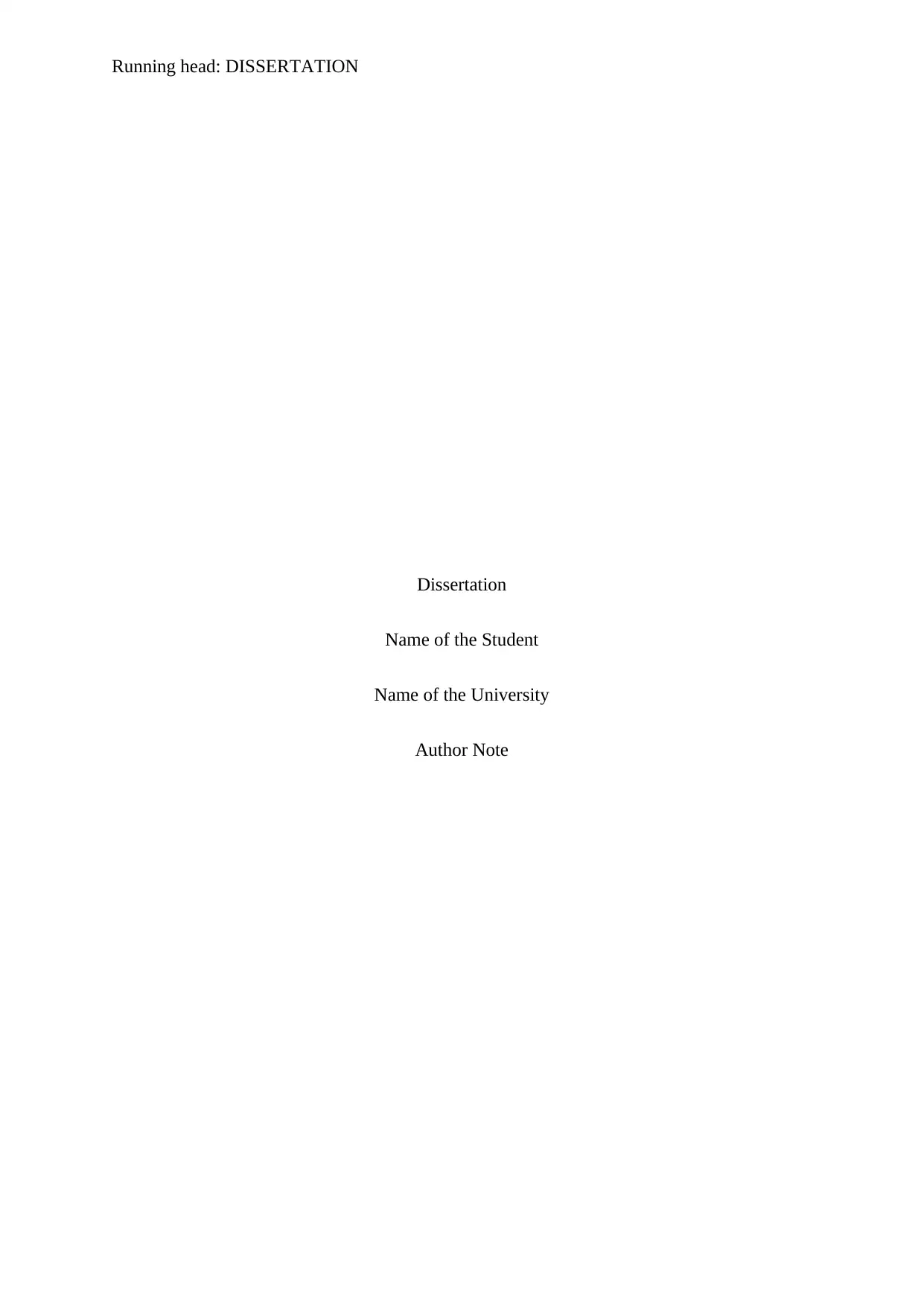
Running head: DISSERTATION
Dissertation
Name of the Student
Name of the University
Author Note
Dissertation
Name of the Student
Name of the University
Author Note
Paraphrase This Document
Need a fresh take? Get an instant paraphrase of this document with our AI Paraphraser
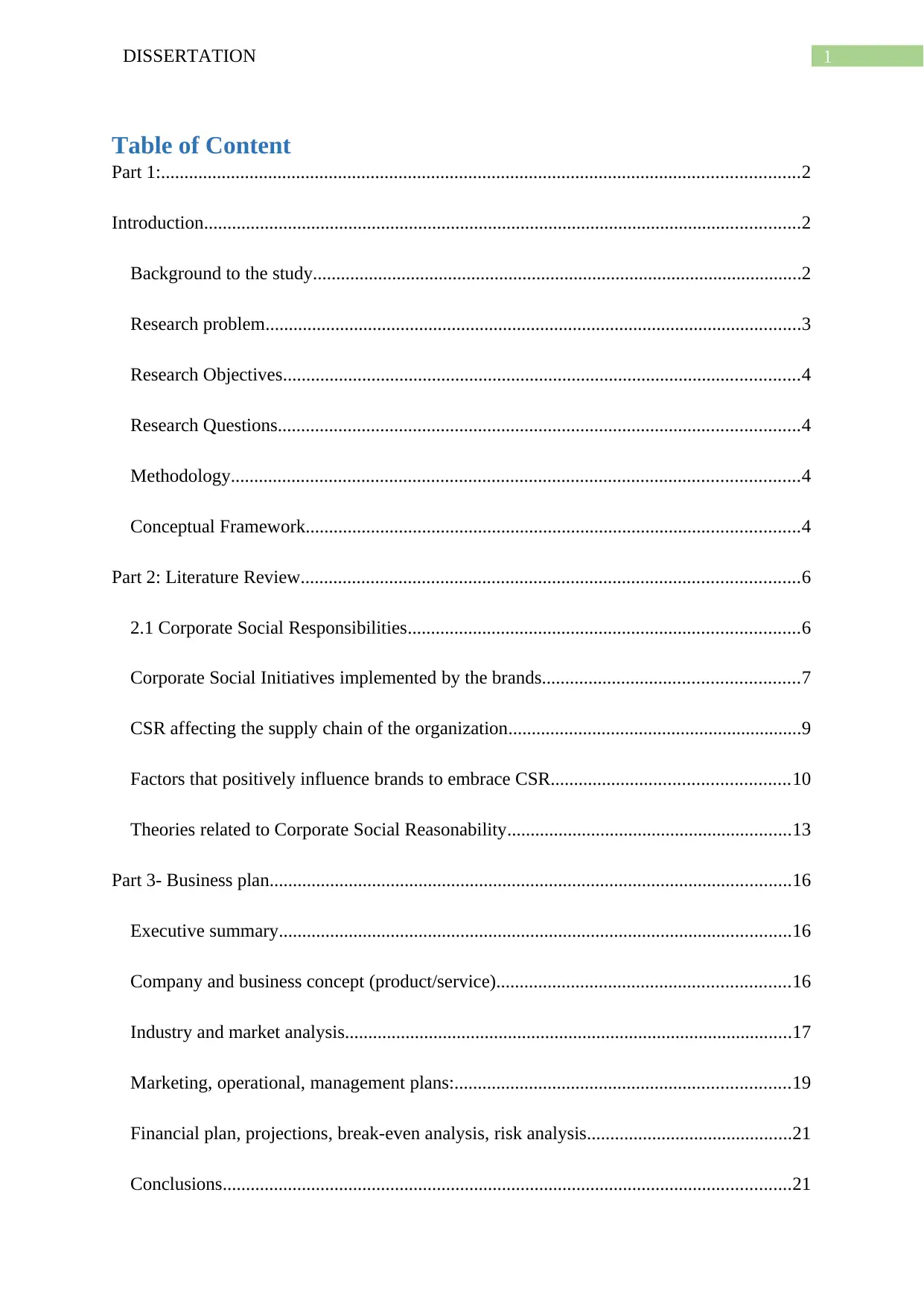
1DISSERTATION
Table of Content
Part 1:.........................................................................................................................................2
Introduction................................................................................................................................2
Background to the study.........................................................................................................2
Research problem...................................................................................................................3
Research Objectives...............................................................................................................4
Research Questions................................................................................................................4
Methodology..........................................................................................................................4
Conceptual Framework..........................................................................................................4
Part 2: Literature Review...........................................................................................................6
2.1 Corporate Social Responsibilities....................................................................................6
Corporate Social Initiatives implemented by the brands.......................................................7
CSR affecting the supply chain of the organization...............................................................9
Factors that positively influence brands to embrace CSR...................................................10
Theories related to Corporate Social Reasonability.............................................................13
Part 3- Business plan................................................................................................................16
Executive summary..............................................................................................................16
Company and business concept (product/service)...............................................................16
Industry and market analysis................................................................................................17
Marketing, operational, management plans:........................................................................19
Financial plan, projections, break-even analysis, risk analysis............................................21
Conclusions..........................................................................................................................21
Table of Content
Part 1:.........................................................................................................................................2
Introduction................................................................................................................................2
Background to the study.........................................................................................................2
Research problem...................................................................................................................3
Research Objectives...............................................................................................................4
Research Questions................................................................................................................4
Methodology..........................................................................................................................4
Conceptual Framework..........................................................................................................4
Part 2: Literature Review...........................................................................................................6
2.1 Corporate Social Responsibilities....................................................................................6
Corporate Social Initiatives implemented by the brands.......................................................7
CSR affecting the supply chain of the organization...............................................................9
Factors that positively influence brands to embrace CSR...................................................10
Theories related to Corporate Social Reasonability.............................................................13
Part 3- Business plan................................................................................................................16
Executive summary..............................................................................................................16
Company and business concept (product/service)...............................................................16
Industry and market analysis................................................................................................17
Marketing, operational, management plans:........................................................................19
Financial plan, projections, break-even analysis, risk analysis............................................21
Conclusions..........................................................................................................................21
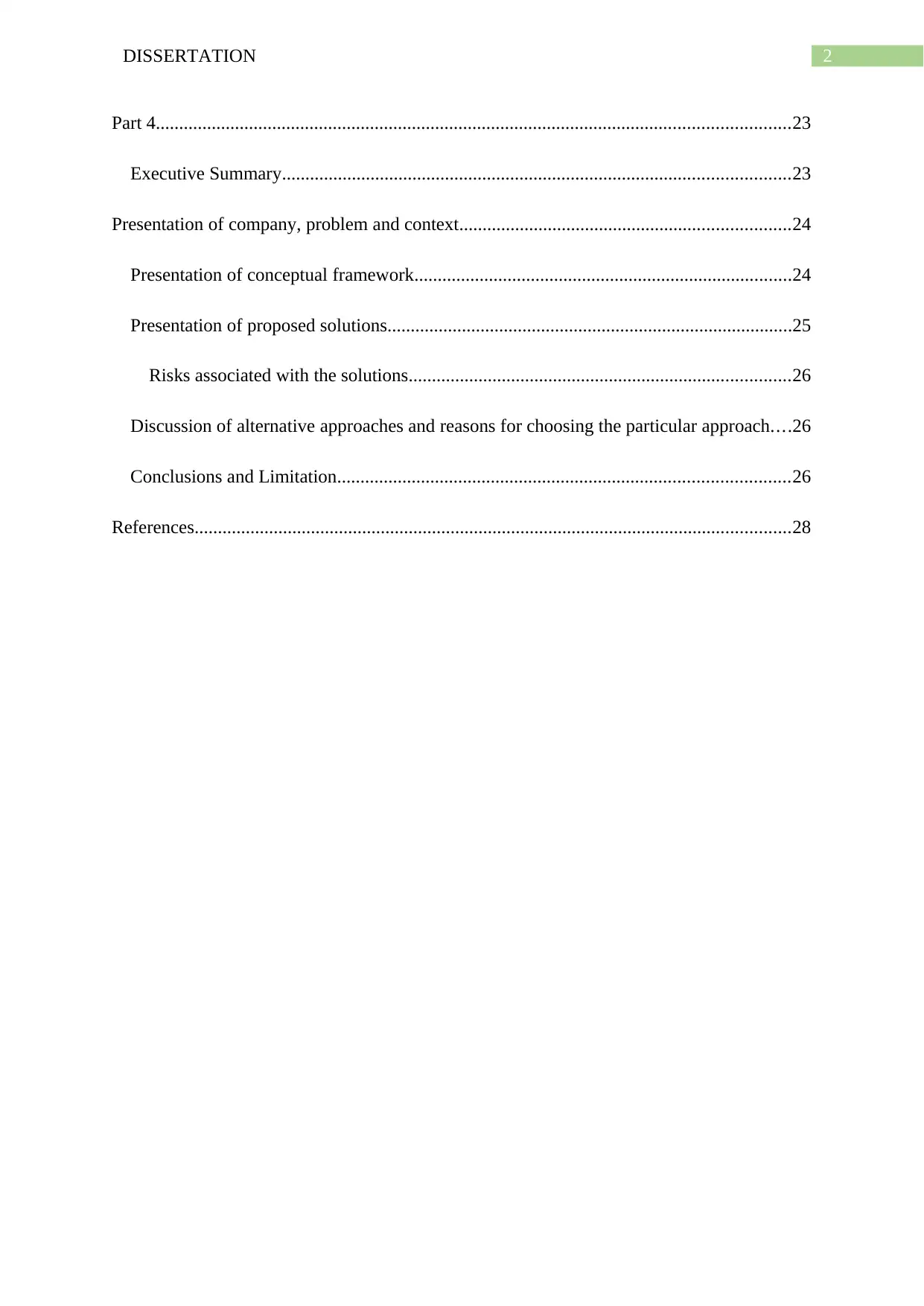
2DISSERTATION
Part 4........................................................................................................................................23
Executive Summary.............................................................................................................23
Presentation of company, problem and context.......................................................................24
Presentation of conceptual framework.................................................................................24
Presentation of proposed solutions.......................................................................................25
Risks associated with the solutions..................................................................................26
Discussion of alternative approaches and reasons for choosing the particular approach....26
Conclusions and Limitation.................................................................................................26
References................................................................................................................................28
Part 4........................................................................................................................................23
Executive Summary.............................................................................................................23
Presentation of company, problem and context.......................................................................24
Presentation of conceptual framework.................................................................................24
Presentation of proposed solutions.......................................................................................25
Risks associated with the solutions..................................................................................26
Discussion of alternative approaches and reasons for choosing the particular approach....26
Conclusions and Limitation.................................................................................................26
References................................................................................................................................28
⊘ This is a preview!⊘
Do you want full access?
Subscribe today to unlock all pages.

Trusted by 1+ million students worldwide
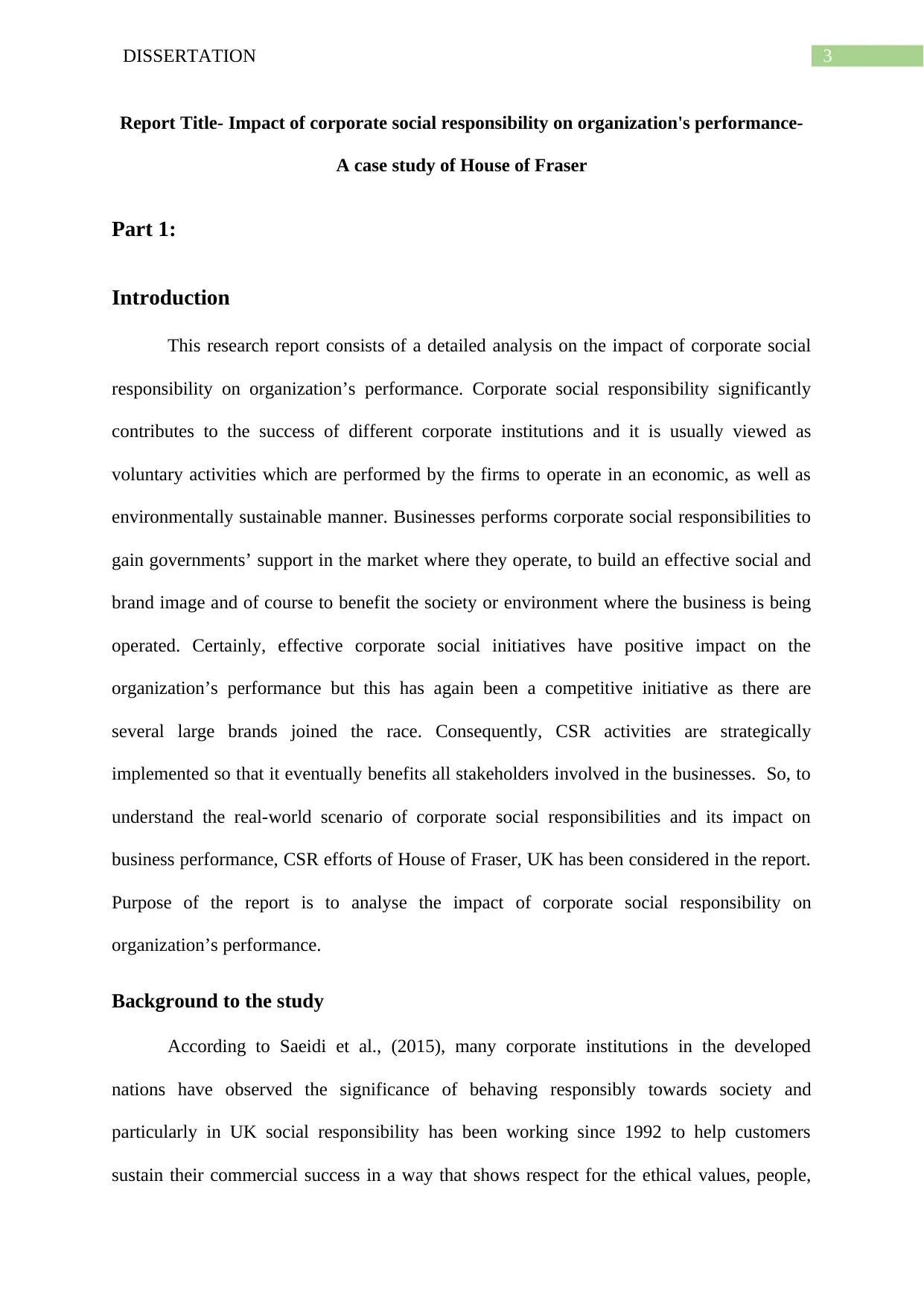
3DISSERTATION
Report Title- Impact of corporate social responsibility on organization's performance-
A case study of House of Fraser
Part 1:
Introduction
This research report consists of a detailed analysis on the impact of corporate social
responsibility on organization’s performance. Corporate social responsibility significantly
contributes to the success of different corporate institutions and it is usually viewed as
voluntary activities which are performed by the firms to operate in an economic, as well as
environmentally sustainable manner. Businesses performs corporate social responsibilities to
gain governments’ support in the market where they operate, to build an effective social and
brand image and of course to benefit the society or environment where the business is being
operated. Certainly, effective corporate social initiatives have positive impact on the
organization’s performance but this has again been a competitive initiative as there are
several large brands joined the race. Consequently, CSR activities are strategically
implemented so that it eventually benefits all stakeholders involved in the businesses. So, to
understand the real-world scenario of corporate social responsibilities and its impact on
business performance, CSR efforts of House of Fraser, UK has been considered in the report.
Purpose of the report is to analyse the impact of corporate social responsibility on
organization’s performance.
Background to the study
According to Saeidi et al., (2015), many corporate institutions in the developed
nations have observed the significance of behaving responsibly towards society and
particularly in UK social responsibility has been working since 1992 to help customers
sustain their commercial success in a way that shows respect for the ethical values, people,
Report Title- Impact of corporate social responsibility on organization's performance-
A case study of House of Fraser
Part 1:
Introduction
This research report consists of a detailed analysis on the impact of corporate social
responsibility on organization’s performance. Corporate social responsibility significantly
contributes to the success of different corporate institutions and it is usually viewed as
voluntary activities which are performed by the firms to operate in an economic, as well as
environmentally sustainable manner. Businesses performs corporate social responsibilities to
gain governments’ support in the market where they operate, to build an effective social and
brand image and of course to benefit the society or environment where the business is being
operated. Certainly, effective corporate social initiatives have positive impact on the
organization’s performance but this has again been a competitive initiative as there are
several large brands joined the race. Consequently, CSR activities are strategically
implemented so that it eventually benefits all stakeholders involved in the businesses. So, to
understand the real-world scenario of corporate social responsibilities and its impact on
business performance, CSR efforts of House of Fraser, UK has been considered in the report.
Purpose of the report is to analyse the impact of corporate social responsibility on
organization’s performance.
Background to the study
According to Saeidi et al., (2015), many corporate institutions in the developed
nations have observed the significance of behaving responsibly towards society and
particularly in UK social responsibility has been working since 1992 to help customers
sustain their commercial success in a way that shows respect for the ethical values, people,
Paraphrase This Document
Need a fresh take? Get an instant paraphrase of this document with our AI Paraphraser
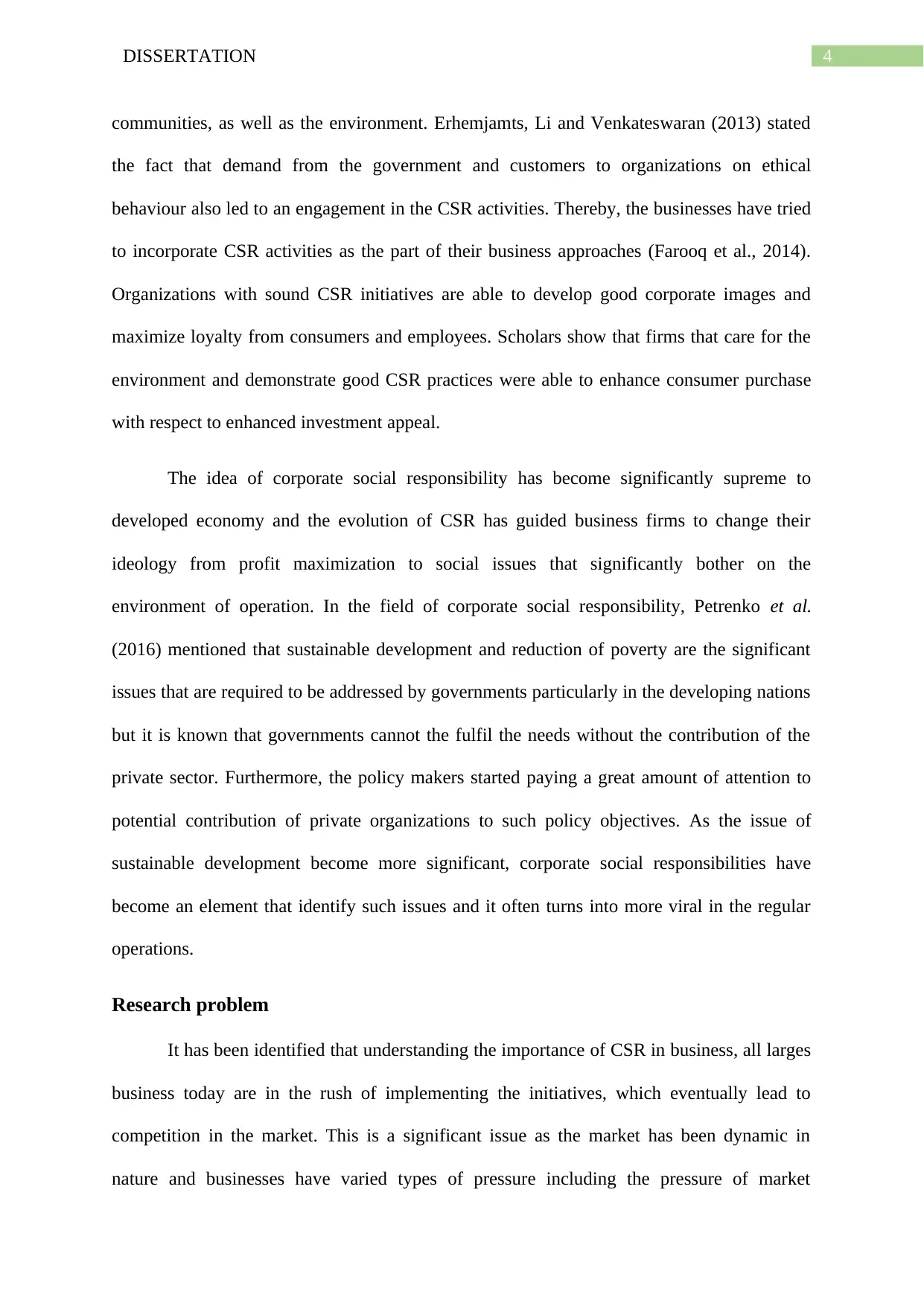
4DISSERTATION
communities, as well as the environment. Erhemjamts, Li and Venkateswaran (2013) stated
the fact that demand from the government and customers to organizations on ethical
behaviour also led to an engagement in the CSR activities. Thereby, the businesses have tried
to incorporate CSR activities as the part of their business approaches (Farooq et al., 2014).
Organizations with sound CSR initiatives are able to develop good corporate images and
maximize loyalty from consumers and employees. Scholars show that firms that care for the
environment and demonstrate good CSR practices were able to enhance consumer purchase
with respect to enhanced investment appeal.
The idea of corporate social responsibility has become significantly supreme to
developed economy and the evolution of CSR has guided business firms to change their
ideology from profit maximization to social issues that significantly bother on the
environment of operation. In the field of corporate social responsibility, Petrenko et al.
(2016) mentioned that sustainable development and reduction of poverty are the significant
issues that are required to be addressed by governments particularly in the developing nations
but it is known that governments cannot the fulfil the needs without the contribution of the
private sector. Furthermore, the policy makers started paying a great amount of attention to
potential contribution of private organizations to such policy objectives. As the issue of
sustainable development become more significant, corporate social responsibilities have
become an element that identify such issues and it often turns into more viral in the regular
operations.
Research problem
It has been identified that understanding the importance of CSR in business, all larges
business today are in the rush of implementing the initiatives, which eventually lead to
competition in the market. This is a significant issue as the market has been dynamic in
nature and businesses have varied types of pressure including the pressure of market
communities, as well as the environment. Erhemjamts, Li and Venkateswaran (2013) stated
the fact that demand from the government and customers to organizations on ethical
behaviour also led to an engagement in the CSR activities. Thereby, the businesses have tried
to incorporate CSR activities as the part of their business approaches (Farooq et al., 2014).
Organizations with sound CSR initiatives are able to develop good corporate images and
maximize loyalty from consumers and employees. Scholars show that firms that care for the
environment and demonstrate good CSR practices were able to enhance consumer purchase
with respect to enhanced investment appeal.
The idea of corporate social responsibility has become significantly supreme to
developed economy and the evolution of CSR has guided business firms to change their
ideology from profit maximization to social issues that significantly bother on the
environment of operation. In the field of corporate social responsibility, Petrenko et al.
(2016) mentioned that sustainable development and reduction of poverty are the significant
issues that are required to be addressed by governments particularly in the developing nations
but it is known that governments cannot the fulfil the needs without the contribution of the
private sector. Furthermore, the policy makers started paying a great amount of attention to
potential contribution of private organizations to such policy objectives. As the issue of
sustainable development become more significant, corporate social responsibilities have
become an element that identify such issues and it often turns into more viral in the regular
operations.
Research problem
It has been identified that understanding the importance of CSR in business, all larges
business today are in the rush of implementing the initiatives, which eventually lead to
competition in the market. This is a significant issue as the market has been dynamic in
nature and businesses have varied types of pressure including the pressure of market
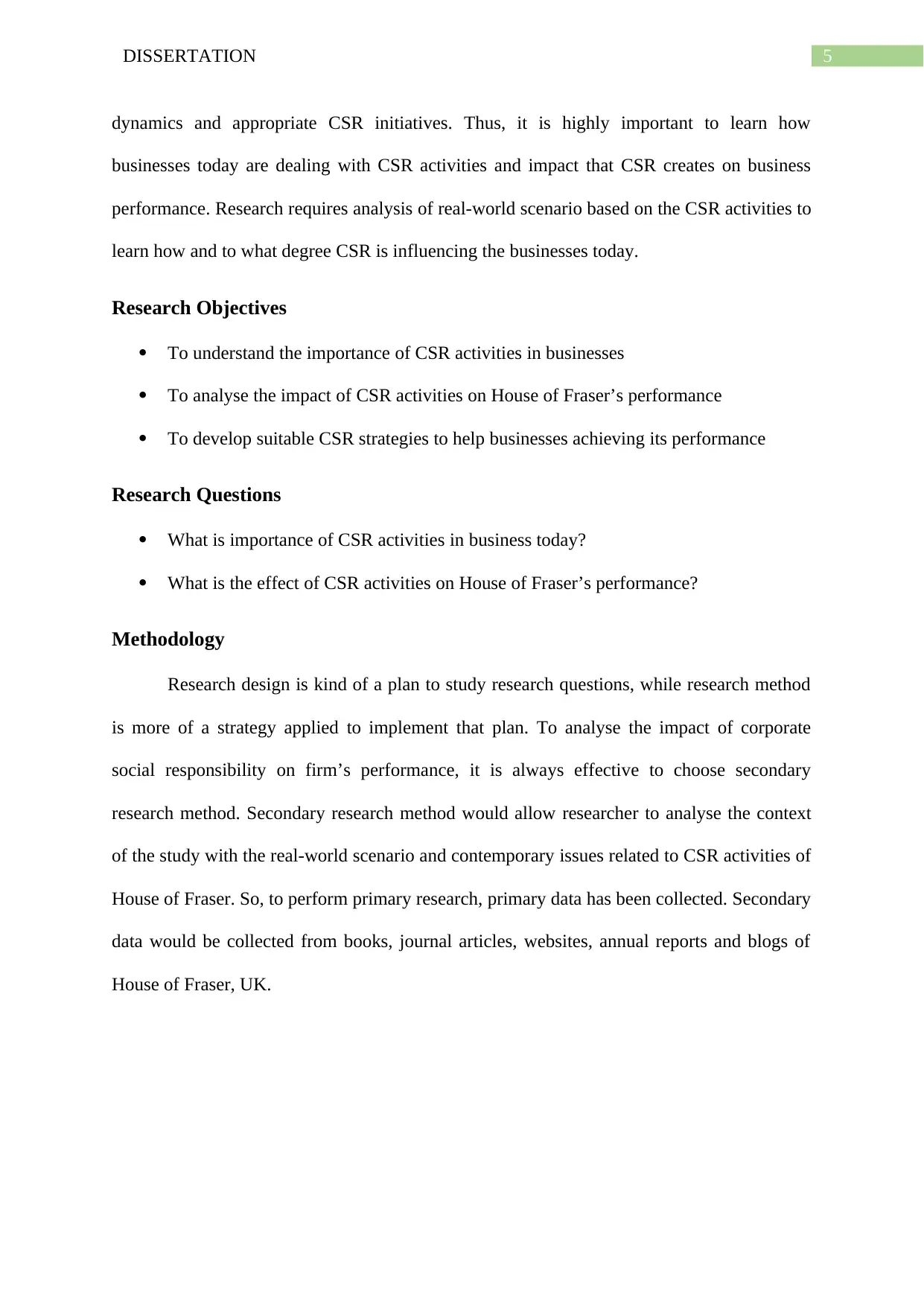
5DISSERTATION
dynamics and appropriate CSR initiatives. Thus, it is highly important to learn how
businesses today are dealing with CSR activities and impact that CSR creates on business
performance. Research requires analysis of real-world scenario based on the CSR activities to
learn how and to what degree CSR is influencing the businesses today.
Research Objectives
To understand the importance of CSR activities in businesses
To analyse the impact of CSR activities on House of Fraser’s performance
To develop suitable CSR strategies to help businesses achieving its performance
Research Questions
What is importance of CSR activities in business today?
What is the effect of CSR activities on House of Fraser’s performance?
Methodology
Research design is kind of a plan to study research questions, while research method
is more of a strategy applied to implement that plan. To analyse the impact of corporate
social responsibility on firm’s performance, it is always effective to choose secondary
research method. Secondary research method would allow researcher to analyse the context
of the study with the real-world scenario and contemporary issues related to CSR activities of
House of Fraser. So, to perform primary research, primary data has been collected. Secondary
data would be collected from books, journal articles, websites, annual reports and blogs of
House of Fraser, UK.
dynamics and appropriate CSR initiatives. Thus, it is highly important to learn how
businesses today are dealing with CSR activities and impact that CSR creates on business
performance. Research requires analysis of real-world scenario based on the CSR activities to
learn how and to what degree CSR is influencing the businesses today.
Research Objectives
To understand the importance of CSR activities in businesses
To analyse the impact of CSR activities on House of Fraser’s performance
To develop suitable CSR strategies to help businesses achieving its performance
Research Questions
What is importance of CSR activities in business today?
What is the effect of CSR activities on House of Fraser’s performance?
Methodology
Research design is kind of a plan to study research questions, while research method
is more of a strategy applied to implement that plan. To analyse the impact of corporate
social responsibility on firm’s performance, it is always effective to choose secondary
research method. Secondary research method would allow researcher to analyse the context
of the study with the real-world scenario and contemporary issues related to CSR activities of
House of Fraser. So, to perform primary research, primary data has been collected. Secondary
data would be collected from books, journal articles, websites, annual reports and blogs of
House of Fraser, UK.
⊘ This is a preview!⊘
Do you want full access?
Subscribe today to unlock all pages.

Trusted by 1+ million students worldwide
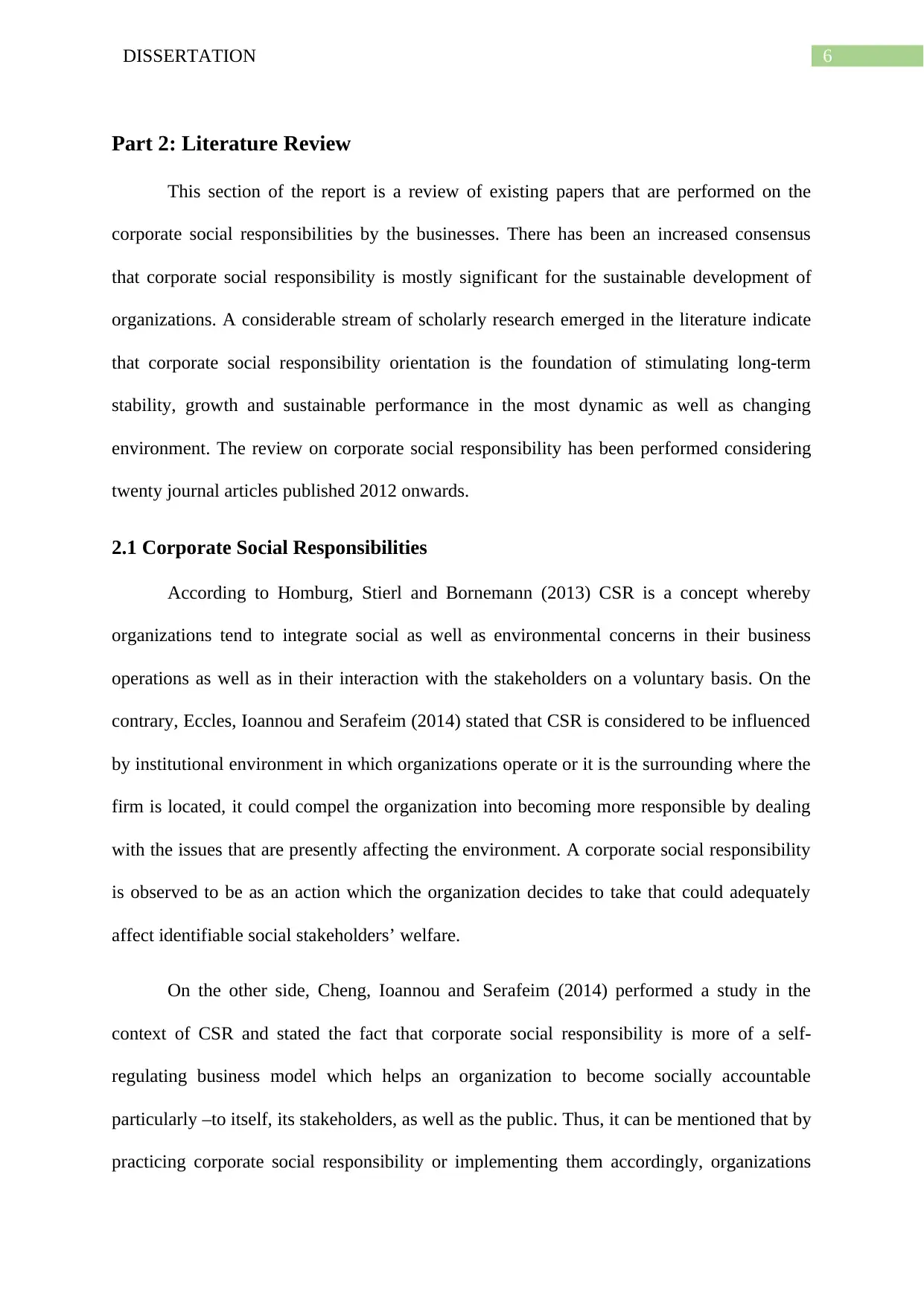
6DISSERTATION
Part 2: Literature Review
This section of the report is a review of existing papers that are performed on the
corporate social responsibilities by the businesses. There has been an increased consensus
that corporate social responsibility is mostly significant for the sustainable development of
organizations. A considerable stream of scholarly research emerged in the literature indicate
that corporate social responsibility orientation is the foundation of stimulating long-term
stability, growth and sustainable performance in the most dynamic as well as changing
environment. The review on corporate social responsibility has been performed considering
twenty journal articles published 2012 onwards.
2.1 Corporate Social Responsibilities
According to Homburg, Stierl and Bornemann (2013) CSR is a concept whereby
organizations tend to integrate social as well as environmental concerns in their business
operations as well as in their interaction with the stakeholders on a voluntary basis. On the
contrary, Eccles, Ioannou and Serafeim (2014) stated that CSR is considered to be influenced
by institutional environment in which organizations operate or it is the surrounding where the
firm is located, it could compel the organization into becoming more responsible by dealing
with the issues that are presently affecting the environment. A corporate social responsibility
is observed to be as an action which the organization decides to take that could adequately
affect identifiable social stakeholders’ welfare.
On the other side, Cheng, Ioannou and Serafeim (2014) performed a study in the
context of CSR and stated the fact that corporate social responsibility is more of a self-
regulating business model which helps an organization to become socially accountable
particularly –to itself, its stakeholders, as well as the public. Thus, it can be mentioned that by
practicing corporate social responsibility or implementing them accordingly, organizations
Part 2: Literature Review
This section of the report is a review of existing papers that are performed on the
corporate social responsibilities by the businesses. There has been an increased consensus
that corporate social responsibility is mostly significant for the sustainable development of
organizations. A considerable stream of scholarly research emerged in the literature indicate
that corporate social responsibility orientation is the foundation of stimulating long-term
stability, growth and sustainable performance in the most dynamic as well as changing
environment. The review on corporate social responsibility has been performed considering
twenty journal articles published 2012 onwards.
2.1 Corporate Social Responsibilities
According to Homburg, Stierl and Bornemann (2013) CSR is a concept whereby
organizations tend to integrate social as well as environmental concerns in their business
operations as well as in their interaction with the stakeholders on a voluntary basis. On the
contrary, Eccles, Ioannou and Serafeim (2014) stated that CSR is considered to be influenced
by institutional environment in which organizations operate or it is the surrounding where the
firm is located, it could compel the organization into becoming more responsible by dealing
with the issues that are presently affecting the environment. A corporate social responsibility
is observed to be as an action which the organization decides to take that could adequately
affect identifiable social stakeholders’ welfare.
On the other side, Cheng, Ioannou and Serafeim (2014) performed a study in the
context of CSR and stated the fact that corporate social responsibility is more of a self-
regulating business model which helps an organization to become socially accountable
particularly –to itself, its stakeholders, as well as the public. Thus, it can be mentioned that by
practicing corporate social responsibility or implementing them accordingly, organizations
Paraphrase This Document
Need a fresh take? Get an instant paraphrase of this document with our AI Paraphraser
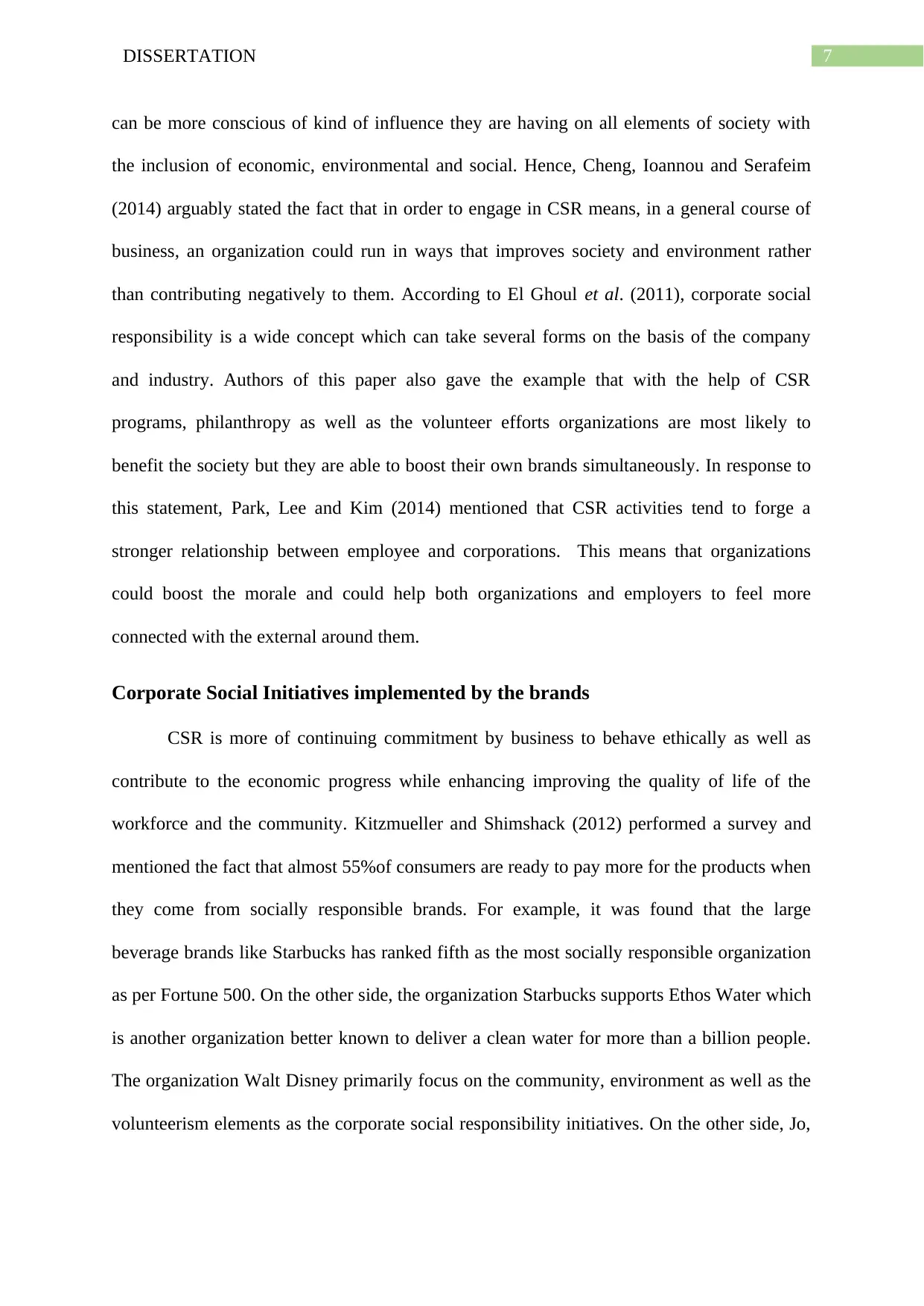
7DISSERTATION
can be more conscious of kind of influence they are having on all elements of society with
the inclusion of economic, environmental and social. Hence, Cheng, Ioannou and Serafeim
(2014) arguably stated the fact that in order to engage in CSR means, in a general course of
business, an organization could run in ways that improves society and environment rather
than contributing negatively to them. According to El Ghoul et al. (2011), corporate social
responsibility is a wide concept which can take several forms on the basis of the company
and industry. Authors of this paper also gave the example that with the help of CSR
programs, philanthropy as well as the volunteer efforts organizations are most likely to
benefit the society but they are able to boost their own brands simultaneously. In response to
this statement, Park, Lee and Kim (2014) mentioned that CSR activities tend to forge a
stronger relationship between employee and corporations. This means that organizations
could boost the morale and could help both organizations and employers to feel more
connected with the external around them.
Corporate Social Initiatives implemented by the brands
CSR is more of continuing commitment by business to behave ethically as well as
contribute to the economic progress while enhancing improving the quality of life of the
workforce and the community. Kitzmueller and Shimshack (2012) performed a survey and
mentioned the fact that almost 55%of consumers are ready to pay more for the products when
they come from socially responsible brands. For example, it was found that the large
beverage brands like Starbucks has ranked fifth as the most socially responsible organization
as per Fortune 500. On the other side, the organization Starbucks supports Ethos Water which
is another organization better known to deliver a clean water for more than a billion people.
The organization Walt Disney primarily focus on the community, environment as well as the
volunteerism elements as the corporate social responsibility initiatives. On the other side, Jo,
can be more conscious of kind of influence they are having on all elements of society with
the inclusion of economic, environmental and social. Hence, Cheng, Ioannou and Serafeim
(2014) arguably stated the fact that in order to engage in CSR means, in a general course of
business, an organization could run in ways that improves society and environment rather
than contributing negatively to them. According to El Ghoul et al. (2011), corporate social
responsibility is a wide concept which can take several forms on the basis of the company
and industry. Authors of this paper also gave the example that with the help of CSR
programs, philanthropy as well as the volunteer efforts organizations are most likely to
benefit the society but they are able to boost their own brands simultaneously. In response to
this statement, Park, Lee and Kim (2014) mentioned that CSR activities tend to forge a
stronger relationship between employee and corporations. This means that organizations
could boost the morale and could help both organizations and employers to feel more
connected with the external around them.
Corporate Social Initiatives implemented by the brands
CSR is more of continuing commitment by business to behave ethically as well as
contribute to the economic progress while enhancing improving the quality of life of the
workforce and the community. Kitzmueller and Shimshack (2012) performed a survey and
mentioned the fact that almost 55%of consumers are ready to pay more for the products when
they come from socially responsible brands. For example, it was found that the large
beverage brands like Starbucks has ranked fifth as the most socially responsible organization
as per Fortune 500. On the other side, the organization Starbucks supports Ethos Water which
is another organization better known to deliver a clean water for more than a billion people.
The organization Walt Disney primarily focus on the community, environment as well as the
volunteerism elements as the corporate social responsibility initiatives. On the other side, Jo,
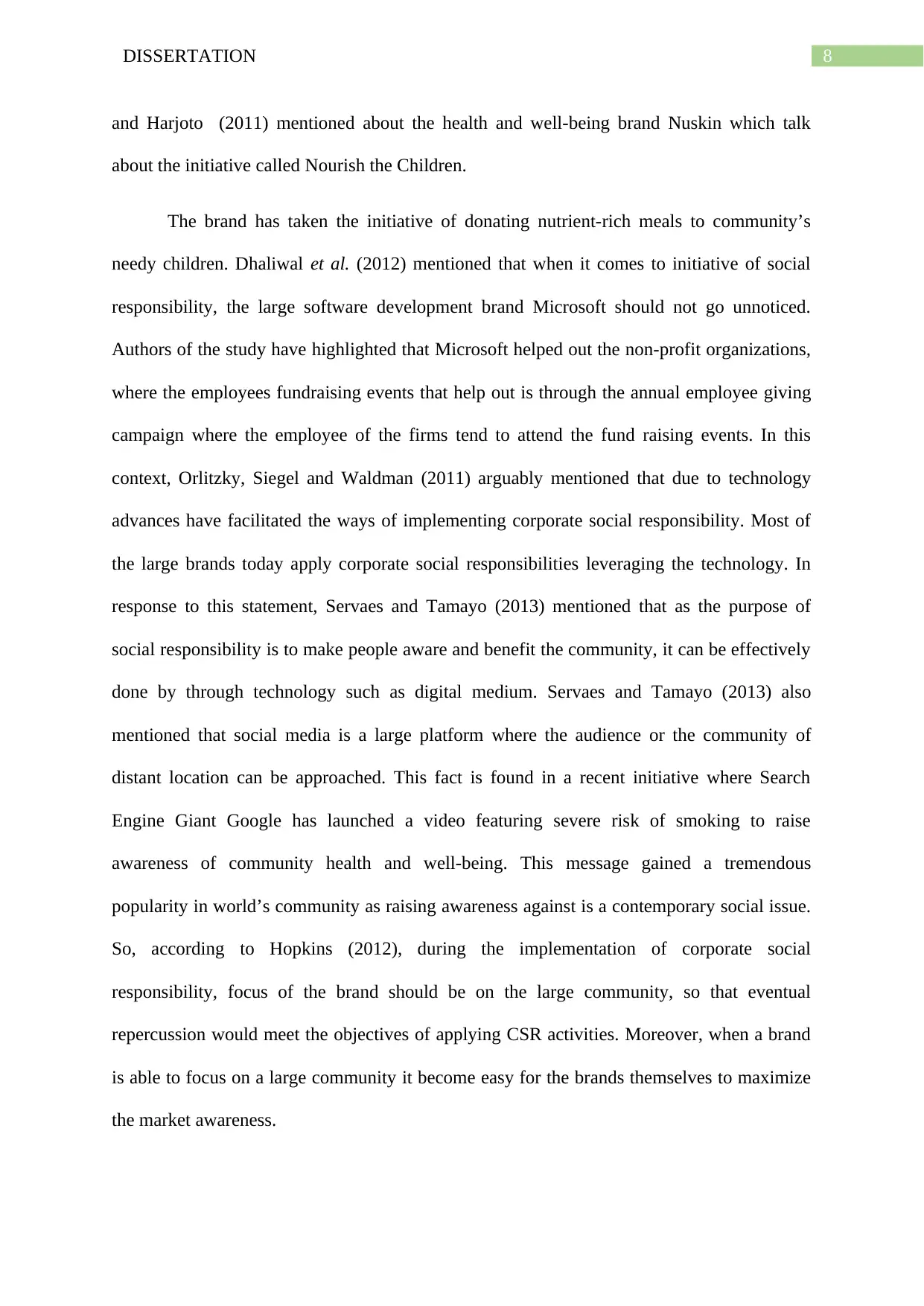
8DISSERTATION
and Harjoto (2011) mentioned about the health and well-being brand Nuskin which talk
about the initiative called Nourish the Children.
The brand has taken the initiative of donating nutrient-rich meals to community’s
needy children. Dhaliwal et al. (2012) mentioned that when it comes to initiative of social
responsibility, the large software development brand Microsoft should not go unnoticed.
Authors of the study have highlighted that Microsoft helped out the non-profit organizations,
where the employees fundraising events that help out is through the annual employee giving
campaign where the employee of the firms tend to attend the fund raising events. In this
context, Orlitzky, Siegel and Waldman (2011) arguably mentioned that due to technology
advances have facilitated the ways of implementing corporate social responsibility. Most of
the large brands today apply corporate social responsibilities leveraging the technology. In
response to this statement, Servaes and Tamayo (2013) mentioned that as the purpose of
social responsibility is to make people aware and benefit the community, it can be effectively
done by through technology such as digital medium. Servaes and Tamayo (2013) also
mentioned that social media is a large platform where the audience or the community of
distant location can be approached. This fact is found in a recent initiative where Search
Engine Giant Google has launched a video featuring severe risk of smoking to raise
awareness of community health and well-being. This message gained a tremendous
popularity in world’s community as raising awareness against is a contemporary social issue.
So, according to Hopkins (2012), during the implementation of corporate social
responsibility, focus of the brand should be on the large community, so that eventual
repercussion would meet the objectives of applying CSR activities. Moreover, when a brand
is able to focus on a large community it become easy for the brands themselves to maximize
the market awareness.
and Harjoto (2011) mentioned about the health and well-being brand Nuskin which talk
about the initiative called Nourish the Children.
The brand has taken the initiative of donating nutrient-rich meals to community’s
needy children. Dhaliwal et al. (2012) mentioned that when it comes to initiative of social
responsibility, the large software development brand Microsoft should not go unnoticed.
Authors of the study have highlighted that Microsoft helped out the non-profit organizations,
where the employees fundraising events that help out is through the annual employee giving
campaign where the employee of the firms tend to attend the fund raising events. In this
context, Orlitzky, Siegel and Waldman (2011) arguably mentioned that due to technology
advances have facilitated the ways of implementing corporate social responsibility. Most of
the large brands today apply corporate social responsibilities leveraging the technology. In
response to this statement, Servaes and Tamayo (2013) mentioned that as the purpose of
social responsibility is to make people aware and benefit the community, it can be effectively
done by through technology such as digital medium. Servaes and Tamayo (2013) also
mentioned that social media is a large platform where the audience or the community of
distant location can be approached. This fact is found in a recent initiative where Search
Engine Giant Google has launched a video featuring severe risk of smoking to raise
awareness of community health and well-being. This message gained a tremendous
popularity in world’s community as raising awareness against is a contemporary social issue.
So, according to Hopkins (2012), during the implementation of corporate social
responsibility, focus of the brand should be on the large community, so that eventual
repercussion would meet the objectives of applying CSR activities. Moreover, when a brand
is able to focus on a large community it become easy for the brands themselves to maximize
the market awareness.
⊘ This is a preview!⊘
Do you want full access?
Subscribe today to unlock all pages.

Trusted by 1+ million students worldwide
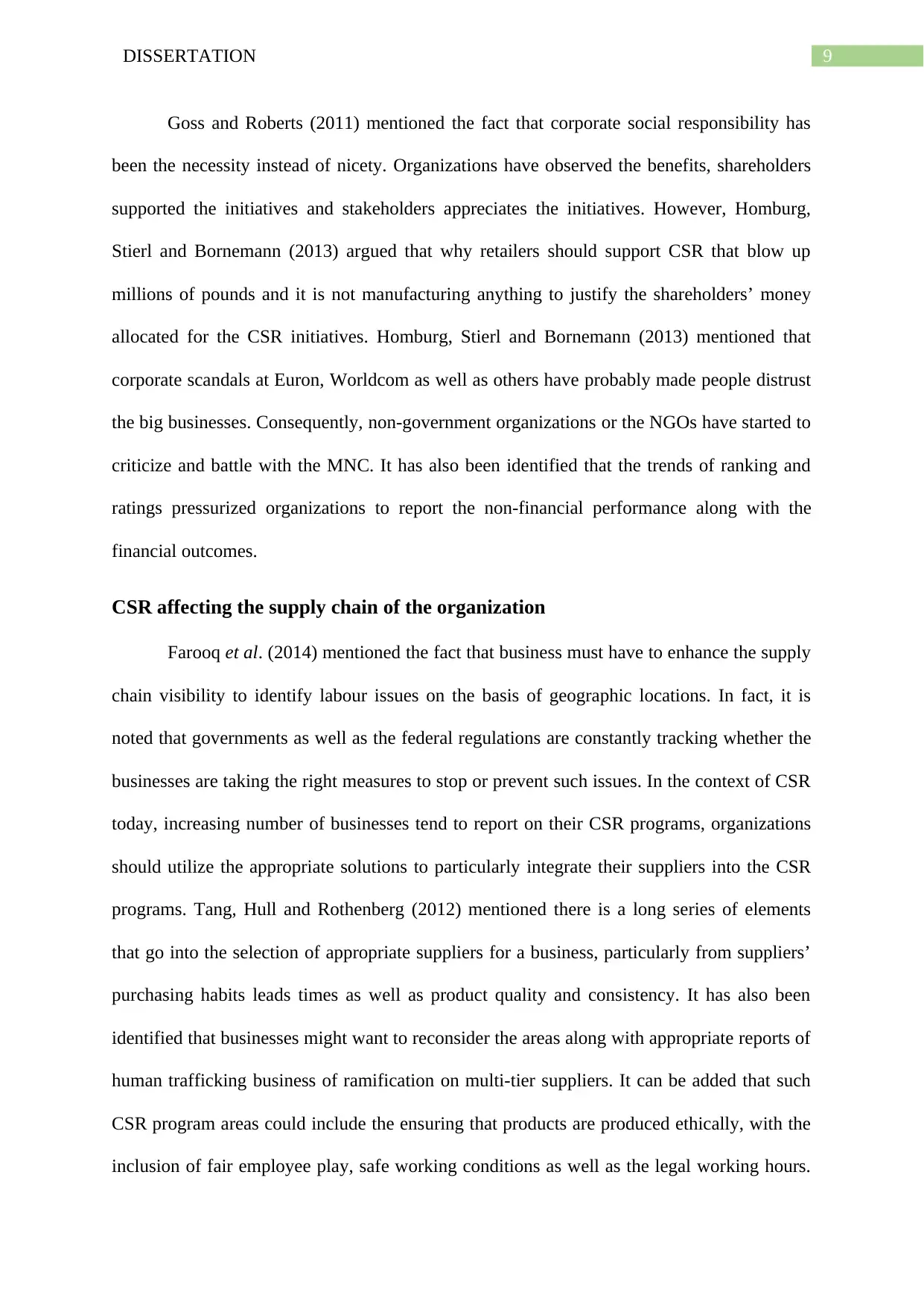
9DISSERTATION
Goss and Roberts (2011) mentioned the fact that corporate social responsibility has
been the necessity instead of nicety. Organizations have observed the benefits, shareholders
supported the initiatives and stakeholders appreciates the initiatives. However, Homburg,
Stierl and Bornemann (2013) argued that why retailers should support CSR that blow up
millions of pounds and it is not manufacturing anything to justify the shareholders’ money
allocated for the CSR initiatives. Homburg, Stierl and Bornemann (2013) mentioned that
corporate scandals at Euron, Worldcom as well as others have probably made people distrust
the big businesses. Consequently, non-government organizations or the NGOs have started to
criticize and battle with the MNC. It has also been identified that the trends of ranking and
ratings pressurized organizations to report the non-financial performance along with the
financial outcomes.
CSR affecting the supply chain of the organization
Farooq et al. (2014) mentioned the fact that business must have to enhance the supply
chain visibility to identify labour issues on the basis of geographic locations. In fact, it is
noted that governments as well as the federal regulations are constantly tracking whether the
businesses are taking the right measures to stop or prevent such issues. In the context of CSR
today, increasing number of businesses tend to report on their CSR programs, organizations
should utilize the appropriate solutions to particularly integrate their suppliers into the CSR
programs. Tang, Hull and Rothenberg (2012) mentioned there is a long series of elements
that go into the selection of appropriate suppliers for a business, particularly from suppliers’
purchasing habits leads times as well as product quality and consistency. It has also been
identified that businesses might want to reconsider the areas along with appropriate reports of
human trafficking business of ramification on multi-tier suppliers. It can be added that such
CSR program areas could include the ensuring that products are produced ethically, with the
inclusion of fair employee play, safe working conditions as well as the legal working hours.
Goss and Roberts (2011) mentioned the fact that corporate social responsibility has
been the necessity instead of nicety. Organizations have observed the benefits, shareholders
supported the initiatives and stakeholders appreciates the initiatives. However, Homburg,
Stierl and Bornemann (2013) argued that why retailers should support CSR that blow up
millions of pounds and it is not manufacturing anything to justify the shareholders’ money
allocated for the CSR initiatives. Homburg, Stierl and Bornemann (2013) mentioned that
corporate scandals at Euron, Worldcom as well as others have probably made people distrust
the big businesses. Consequently, non-government organizations or the NGOs have started to
criticize and battle with the MNC. It has also been identified that the trends of ranking and
ratings pressurized organizations to report the non-financial performance along with the
financial outcomes.
CSR affecting the supply chain of the organization
Farooq et al. (2014) mentioned the fact that business must have to enhance the supply
chain visibility to identify labour issues on the basis of geographic locations. In fact, it is
noted that governments as well as the federal regulations are constantly tracking whether the
businesses are taking the right measures to stop or prevent such issues. In the context of CSR
today, increasing number of businesses tend to report on their CSR programs, organizations
should utilize the appropriate solutions to particularly integrate their suppliers into the CSR
programs. Tang, Hull and Rothenberg (2012) mentioned there is a long series of elements
that go into the selection of appropriate suppliers for a business, particularly from suppliers’
purchasing habits leads times as well as product quality and consistency. It has also been
identified that businesses might want to reconsider the areas along with appropriate reports of
human trafficking business of ramification on multi-tier suppliers. It can be added that such
CSR program areas could include the ensuring that products are produced ethically, with the
inclusion of fair employee play, safe working conditions as well as the legal working hours.
Paraphrase This Document
Need a fresh take? Get an instant paraphrase of this document with our AI Paraphraser
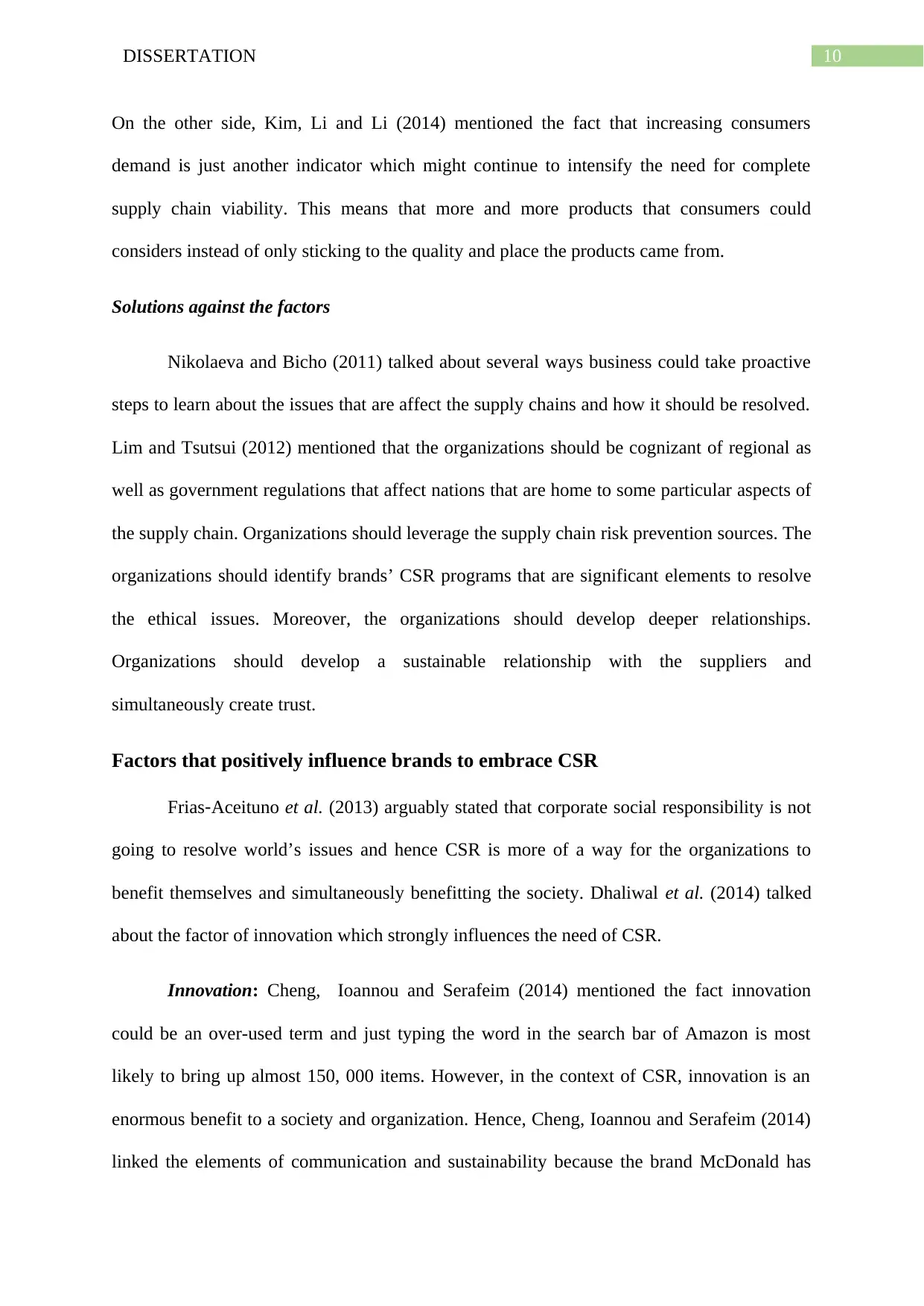
10DISSERTATION
On the other side, Kim, Li and Li (2014) mentioned the fact that increasing consumers
demand is just another indicator which might continue to intensify the need for complete
supply chain viability. This means that more and more products that consumers could
considers instead of only sticking to the quality and place the products came from.
Solutions against the factors
Nikolaeva and Bicho (2011) talked about several ways business could take proactive
steps to learn about the issues that are affect the supply chains and how it should be resolved.
Lim and Tsutsui (2012) mentioned that the organizations should be cognizant of regional as
well as government regulations that affect nations that are home to some particular aspects of
the supply chain. Organizations should leverage the supply chain risk prevention sources. The
organizations should identify brands’ CSR programs that are significant elements to resolve
the ethical issues. Moreover, the organizations should develop deeper relationships.
Organizations should develop a sustainable relationship with the suppliers and
simultaneously create trust.
Factors that positively influence brands to embrace CSR
Frias‐Aceituno et al. (2013) arguably stated that corporate social responsibility is not
going to resolve world’s issues and hence CSR is more of a way for the organizations to
benefit themselves and simultaneously benefitting the society. Dhaliwal et al. (2014) talked
about the factor of innovation which strongly influences the need of CSR.
Innovation: Cheng, Ioannou and Serafeim (2014) mentioned the fact innovation
could be an over-used term and just typing the word in the search bar of Amazon is most
likely to bring up almost 150, 000 items. However, in the context of CSR, innovation is an
enormous benefit to a society and organization. Hence, Cheng, Ioannou and Serafeim (2014)
linked the elements of communication and sustainability because the brand McDonald has
On the other side, Kim, Li and Li (2014) mentioned the fact that increasing consumers
demand is just another indicator which might continue to intensify the need for complete
supply chain viability. This means that more and more products that consumers could
considers instead of only sticking to the quality and place the products came from.
Solutions against the factors
Nikolaeva and Bicho (2011) talked about several ways business could take proactive
steps to learn about the issues that are affect the supply chains and how it should be resolved.
Lim and Tsutsui (2012) mentioned that the organizations should be cognizant of regional as
well as government regulations that affect nations that are home to some particular aspects of
the supply chain. Organizations should leverage the supply chain risk prevention sources. The
organizations should identify brands’ CSR programs that are significant elements to resolve
the ethical issues. Moreover, the organizations should develop deeper relationships.
Organizations should develop a sustainable relationship with the suppliers and
simultaneously create trust.
Factors that positively influence brands to embrace CSR
Frias‐Aceituno et al. (2013) arguably stated that corporate social responsibility is not
going to resolve world’s issues and hence CSR is more of a way for the organizations to
benefit themselves and simultaneously benefitting the society. Dhaliwal et al. (2014) talked
about the factor of innovation which strongly influences the need of CSR.
Innovation: Cheng, Ioannou and Serafeim (2014) mentioned the fact innovation
could be an over-used term and just typing the word in the search bar of Amazon is most
likely to bring up almost 150, 000 items. However, in the context of CSR, innovation is an
enormous benefit to a society and organization. Hence, Cheng, Ioannou and Serafeim (2014)
linked the elements of communication and sustainability because the brand McDonald has
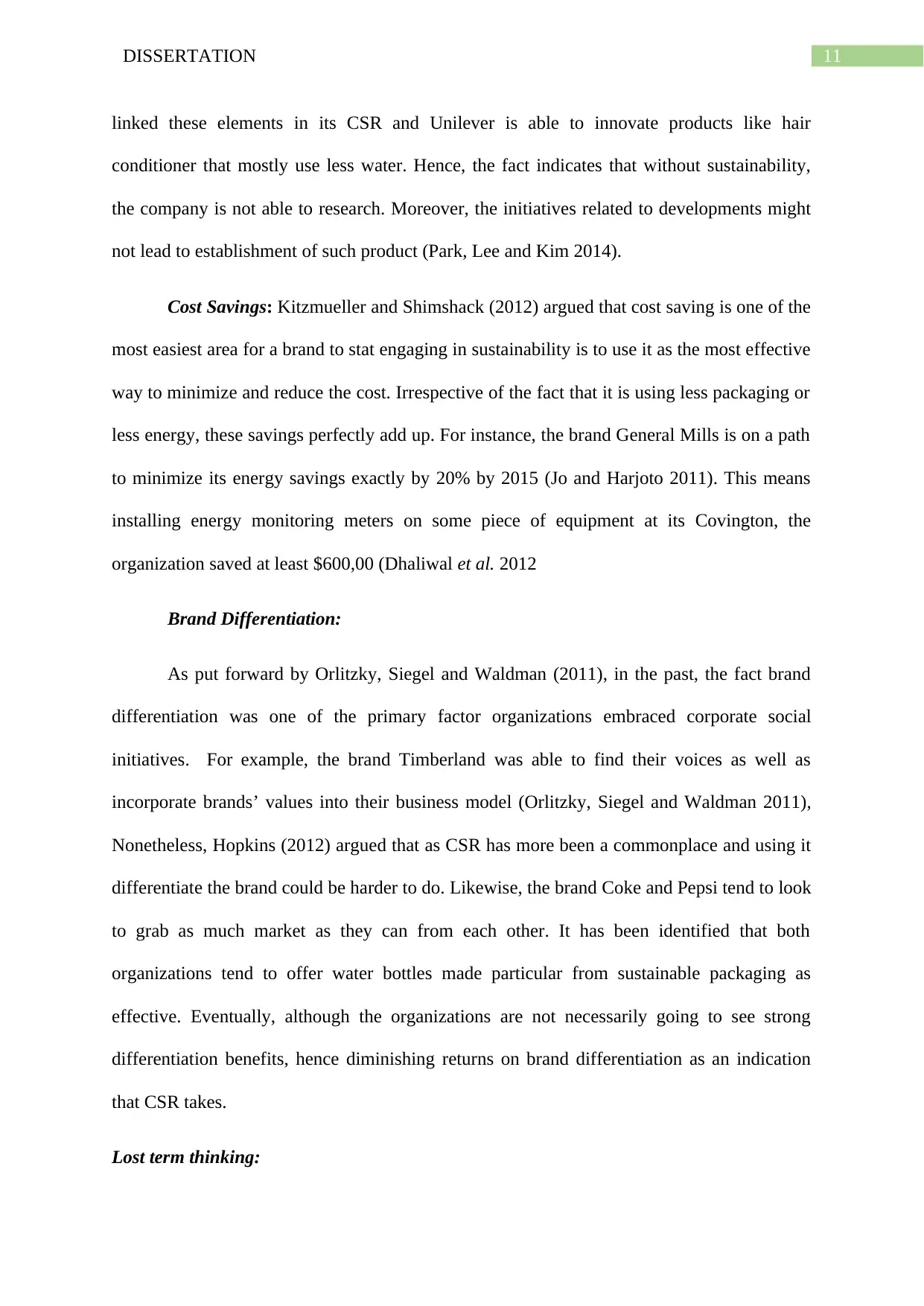
11DISSERTATION
linked these elements in its CSR and Unilever is able to innovate products like hair
conditioner that mostly use less water. Hence, the fact indicates that without sustainability,
the company is not able to research. Moreover, the initiatives related to developments might
not lead to establishment of such product (Park, Lee and Kim 2014).
Cost Savings: Kitzmueller and Shimshack (2012) argued that cost saving is one of the
most easiest area for a brand to stat engaging in sustainability is to use it as the most effective
way to minimize and reduce the cost. Irrespective of the fact that it is using less packaging or
less energy, these savings perfectly add up. For instance, the brand General Mills is on a path
to minimize its energy savings exactly by 20% by 2015 (Jo and Harjoto 2011). This means
installing energy monitoring meters on some piece of equipment at its Covington, the
organization saved at least $600,00 (Dhaliwal et al. 2012
Brand Differentiation:
As put forward by Orlitzky, Siegel and Waldman (2011), in the past, the fact brand
differentiation was one of the primary factor organizations embraced corporate social
initiatives. For example, the brand Timberland was able to find their voices as well as
incorporate brands’ values into their business model (Orlitzky, Siegel and Waldman 2011),
Nonetheless, Hopkins (2012) argued that as CSR has more been a commonplace and using it
differentiate the brand could be harder to do. Likewise, the brand Coke and Pepsi tend to look
to grab as much market as they can from each other. It has been identified that both
organizations tend to offer water bottles made particular from sustainable packaging as
effective. Eventually, although the organizations are not necessarily going to see strong
differentiation benefits, hence diminishing returns on brand differentiation as an indication
that CSR takes.
Lost term thinking:
linked these elements in its CSR and Unilever is able to innovate products like hair
conditioner that mostly use less water. Hence, the fact indicates that without sustainability,
the company is not able to research. Moreover, the initiatives related to developments might
not lead to establishment of such product (Park, Lee and Kim 2014).
Cost Savings: Kitzmueller and Shimshack (2012) argued that cost saving is one of the
most easiest area for a brand to stat engaging in sustainability is to use it as the most effective
way to minimize and reduce the cost. Irrespective of the fact that it is using less packaging or
less energy, these savings perfectly add up. For instance, the brand General Mills is on a path
to minimize its energy savings exactly by 20% by 2015 (Jo and Harjoto 2011). This means
installing energy monitoring meters on some piece of equipment at its Covington, the
organization saved at least $600,00 (Dhaliwal et al. 2012
Brand Differentiation:
As put forward by Orlitzky, Siegel and Waldman (2011), in the past, the fact brand
differentiation was one of the primary factor organizations embraced corporate social
initiatives. For example, the brand Timberland was able to find their voices as well as
incorporate brands’ values into their business model (Orlitzky, Siegel and Waldman 2011),
Nonetheless, Hopkins (2012) argued that as CSR has more been a commonplace and using it
differentiate the brand could be harder to do. Likewise, the brand Coke and Pepsi tend to look
to grab as much market as they can from each other. It has been identified that both
organizations tend to offer water bottles made particular from sustainable packaging as
effective. Eventually, although the organizations are not necessarily going to see strong
differentiation benefits, hence diminishing returns on brand differentiation as an indication
that CSR takes.
Lost term thinking:
⊘ This is a preview!⊘
Do you want full access?
Subscribe today to unlock all pages.

Trusted by 1+ million students worldwide
1 out of 33
Related Documents
Your All-in-One AI-Powered Toolkit for Academic Success.
+13062052269
info@desklib.com
Available 24*7 on WhatsApp / Email
![[object Object]](/_next/static/media/star-bottom.7253800d.svg)
Unlock your academic potential
Copyright © 2020–2025 A2Z Services. All Rights Reserved. Developed and managed by ZUCOL.




